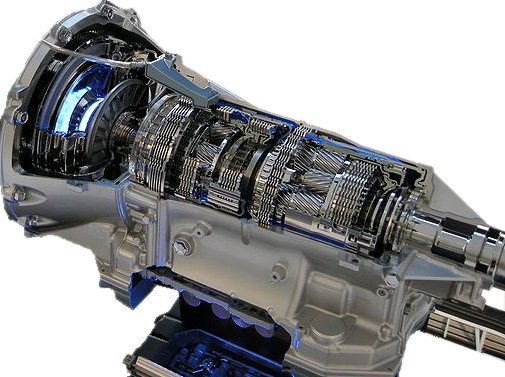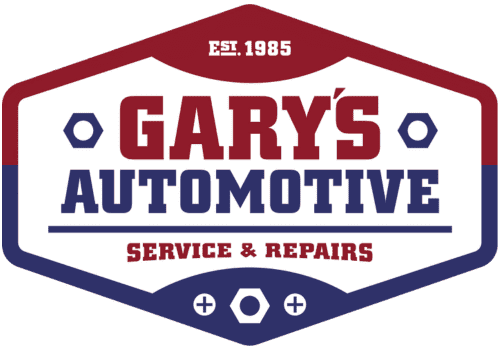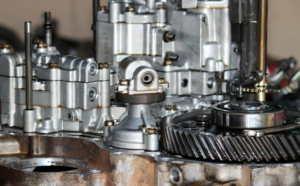“What happens when you rebuild a transmission?” is a question we hear often from clients who need serious transmission work on their vehicles. This guide explains the basics of what transmissions do in a car or truck. Learn the difference between repairing, rebuilding, and replacing a transmission. And know the signs of possible transmission problems so you can address them early and hopefully avoid costly solutions.

Cutaway of an automatic transmission
Image by Silverxxx on Wikimedia Commons
What Is a Transmission, and How Does It Work?
Your vehicle’s transmission is a middleman, transferring power from the engine to the car’s or truck’s wheels by shifting gears with a torque converter to go faster or slower. There are two basic types of transmission: automatic and manual.
Most people today choose vehicles with automatic transmissions because they are easier to operate. The car detects when to shift up or down based on the driver’s use of the gas pedal or brake. Although automatics weren’t common until the late 1950s, they’ve actually been around since World War II.
Automatics come in a few different versions:
- Direct-shift gearbox (uses two clutches for smooth and fast acceleration)
- Tiptronic (allows for manual shifting in some situations)
- Hydraulic (uses fluid inside the transmission to operate)
- Single-gear (used in electric vehicles)
- CVT (continuously variable transmission used in ATVs and hybrid cars)
Manual transmissions allow the driver to decide when to change gears instead of the vehicle doing it automatically. On a regular manual, the driver uses a third pedal on the floor — the clutch — to engage the transmission whenever shifting up or down.
There are multiple subtypes of manual transmissions:
- Dual clutch (one clutch for even gears and another for odd gears)
- Unsynchronized (old “rock crushers” used in trucks)
- Synchronized (aka constant mesh, which eliminates double clutching)
- Automated (a computer controls the clutch under manual direction)
- Single clutch (similar to automated manual transmissions)
- Preselector (used until the 1950s with a vacuum or hydraulic shift)
What Causes Transmission Failure?
There are many things that can cause your transmission to malfunction, depending on what type it is:
- Fluid leaks
- Worn gears
- Dirty parts
- Bad gaskets or seals
- Loose or worn bearing
- Broken shift synchronizer rings
- Worn or improperly set clutch pedal
Age and maintenance have a lot to do with the performance of your transmission. Driving habits with manual transmissions are also a factor, such as improper shifting technique or grinding through gears without properly engaging them.

Schematic of a standard gearbox with a manual transmission
Image by World arm lamp on Wikimedia Commons
Signs of a Transmission Problem
While what seems like transmission problems can sometimes be attributed to another cause, there are some telltale signs to watch out for:
- Car not staying in gear or slipping out of selected gear
- No power and can’t accelerate
- Delayed shifting into desired gear
- Vehicle revving high as it attempts to shift
- Leaking transmission fluid (usually red)
- Burning smell from leaking fluid or grinding metal
- Weird noises, like clunking or buzzing
- Check engine or overdrive light illuminated on dashboard
- Clutch pedal engaging too high or too low
Most people who come to our shop in Langley, BC have the classic symptoms of a transmission issue: they try to shift up to merge on a highway or go faster, but the car is sluggish and just won’t speed up.
It feels like something is holding the vehicle back, and they may hear banging noises or clicking as they try to shift or use the accelerator pedal. Often these signs happen sporadically at first but become more frequent as the transmission breaks down.
What Is Involved in Rebuilding a Transmission?
Sometimes a transmission repair is a relatively simple job, like fixing a leak or adjusting a clutch pedal. We always encourage our customers to make an appointment as soon as they have an inkling of a vehicle problem. This way, we can catch it early and hopefully take care of it quickly and inexpensively.
But when transmission problems are more serious, the transmission needs to be rebuilt. What does this involve?
A transmission rebuild means your mechanic removes the entire transmission from the car, van, or truck. They clean and inspect all the parts, replacing anything that’s broken beyond repair. Then, they reassemble the system and put it back in the vehicle. This process is the same whether rebuilding a manual transmission or an automatic one.
How Much Does It Cost to Rebuild Your Transmission?
A transmission rebuild runs approximately $2,000 to $4,000, based on various factors. We are often asked about manual vs. automatic transmission repair costs. Manual transmissions are generally cheaper to repair because they’re less complicated.
The make and model of the automobile also come into play. Luxury vehicles, some sports cars, large vehicles, and new models tend to cost more to rebuild.
Other transmission rebuild cost factors include:
- Age and condition of the vehicle
- Labour costs for your geographic area
- Using OEM (manufacturer) vs. third-party parts
- Going to a dealership (pricier) vs. an independent mechanic (less costly)
What If the Transmission Has to Be Replaced?
In certain cases, rebuilding the transmission isn’t possible, and it must be completely replaced. This costs about twice as much as a rebuild, so you need to think carefully about the value of the vehicle before committing to it.
There is one advantage to replacing your transmission, though. You’ll have a whole new transmission system in the end. As long as you avoid problems that led to your transmission problems in the first place, it should last for many years.
You can minimize the likelihood of future major transmission repair jobs by keeping up with maintenance, avoiding excessive towing, and using proper shifting techniques with a manual transmission.


